Indonesia's Automation and Control System Market Size
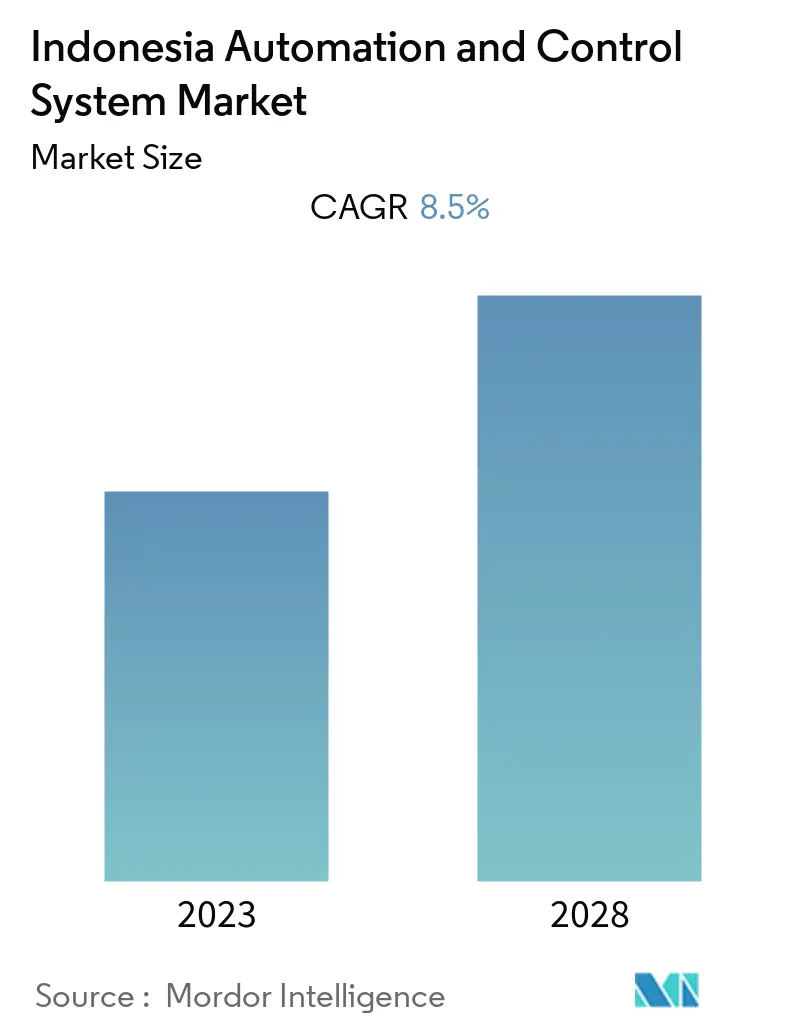
| Study Period | 2017-2027 |
| Base Year For Estimation | 2021 |
| Forecast Data Period | 2024 - 2028 |
| Historical Data Period | 2018 - 2020 |
| CAGR | 8.50 % |
| Market Concentration | Medium |
Major Players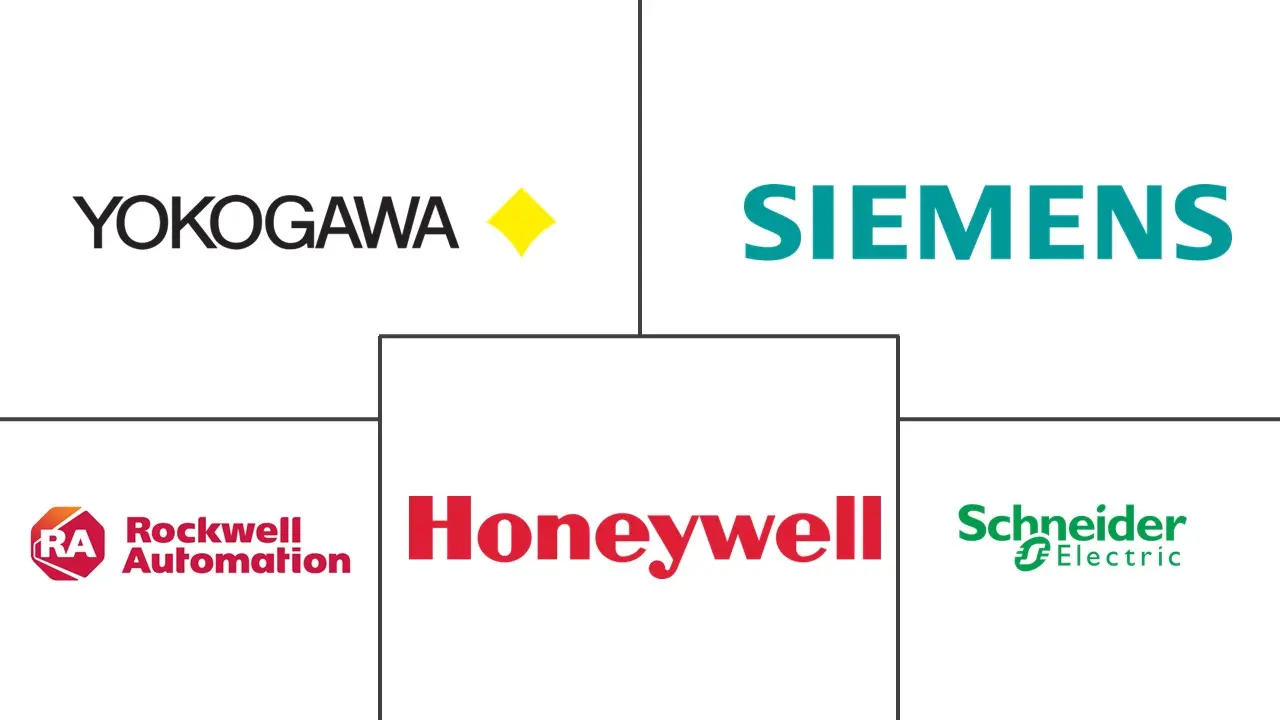
*Disclaimer: Major Players sorted in no particular order |
Need a report that reflects how COVID-19 has impacted this market and its growth?
Indonesia's Automation and Control System Market Analysis
The Indonesia Automation and Control System Market is expected to register a CAGR of 8.5% over the forecast period. With Indonesia's steady amalgamation with the world's economy, Indonesia's Automation and Control System will play an important role in bringing costs down.
- Growing government funding to encourage automated systems in numerous industrial verticals, booming demand for automation from different manufacturing sectors, growing innovations in industrial robotics, swelling technological advancements in manufacturing, and demand for mass production and related supply chain to cater to the rising population are the important factors driving the growth of automation and process control systems market in Indonesia.
- The manufacturing industry in Indonesia contributed the most to the country's 7.07% economic growth in the second quarter of 2021, with a 6.91% growth despite pressure from the pandemic, according to the Ministry of Investment. To further accelerate the growth of the manufacturing sector, the Indonesian government plans to implement industry 4.0 through the Ministry of Industry's Making Indonesia 4.0 roadmap. Such initiatives are further expected to promote the usage of automation technologies in the sector.
- The demand for automation and control systems is also witnessing a rise in the energy sector with the development of smart city programs. Indonesia is pushing forward smart city solutions and has kicked off an ambitious digitalization program in recent years called the 100 Smart Cities Movement. The initiative is also a part of the government's plan to address urbanization issues, where about 83% of the Indonesian population will live in urban areas by 2045.
- In the initial months of the COVID-19 outbreak, the supply chain disruptions caused by the pandemic severely hindered the operations of the companies across different end-user industries in Indonesia. However, COVID-19 has acted as a technology accelerator for many sectors. Automation has allowed many projects to continue or resume faster and has demonstrated that remote work is an efficient way to maintain operations while lowering costs.
- However, the initial costs associated with automation and control systems are high. According to Steven Douglas Corporation, the average cost for new equipment can range from USD 28,000 for a standalone robotic arm to hundreds of thousands of dollars and up for a complete industrial automation system. Such factors might hinder the market growth.
Indonesia's Automation and Control System Market Trends
This section covers the major market trends shaping the Indonesia Automation & Control System Market according to our research experts:
Food and Beverages to Drive the Indonesia Automation and Control System Market
- The food and beverage industry forms one of the most important contributors to the country's GDP. Abundant natural resources and increasing domestic demand support the strength of Indonesia's food and beverage industry. Also, according to Industry Minister Agus Gumiwang Kartasasmita, in the second quarter of 2022, the food and beverage industry contributed 38.38% to the GDP of the non-oil and gas industry, making it the sub-sector with the most significant GDP contribution in Indonesia.
- The growing demand for digital transformation in the country's food and beverage sector is anticipated to contribute to the growth of automation and control systems. The Indonesian government urges its local food and beverage industry to embrace digital advancement and shift towards using local raw ingredients for manufacturing as part of the national Making Industry 4.0 industrial strategy.
- In recent years, the Making Indonesia 4.0 strategy has been announced with critical technologies such as the Internet of Things (IoT), automation, robotics, artificial intelligence, and Sensor technology as its core to elevate Indonesia's status into a global Top 10 economy by 2030. The food and beverage industry has been identified as one of the top priority sectors in this strategy.
- Food safety is an important factor in the food and beverage industry. COVID-19 has further increased the focus on this factor. Many manufacturers were required to check and improve their food safety. Robots can help to improve food safety by removing the need for human touches. Consequently, the risk of cross-contamination can be significantly reduced in food manufacturing facilities by using robots for particular food handling tasks.
- Moreover, the demand for packaged food is rising in Indonesia as well as globally. Previously, packaging facilities used manual methods to process food items, such as using human workers to pick and place food items from one place to another. However, many food packaging facilities now use complex machines throughout the assembly line of food packaging.
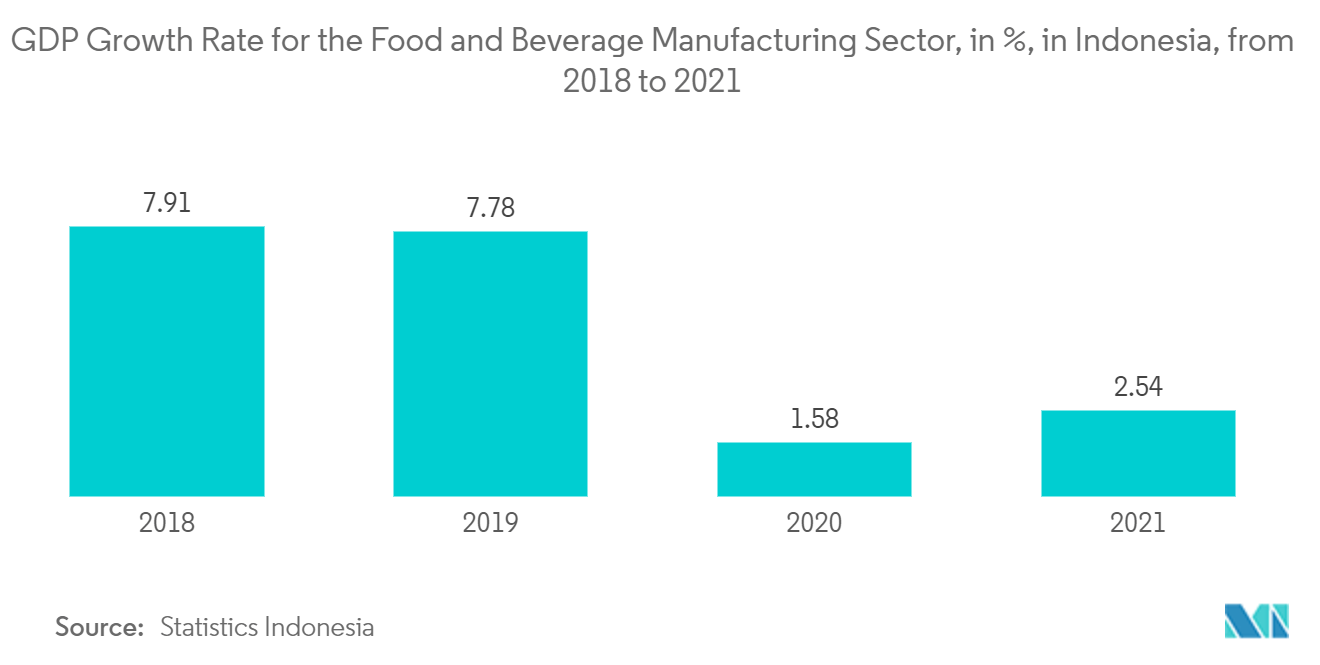
DCS Holds a Dominant Position in Indonesia Automation and Control System Market
- A Distributed Control System (DCS) is integrated as a control architecture comprising a supervisory level of control that oversees multiple integrated sub-systems responsible for managing the details of a localized process. The significant usage of DCS is to control industrial processes such as oil and gas refineries, oil production, etc.
- The Distributed Control Systems are specially designed with redundancy and diagnostic capabilities for improving control reliability and performance. They provide greater flexibility to control distributed discrete field devices and their operating stations.
- One of the primary advantages of DCS is its scalability. A DCS has the capability to be incorporated in an initial installation as a large, integrated system. It can also be deployed as a standalone system that can be added to as planned or needed.
- Factors like increasing demand in the power and energy sectors and rising industrial infrastructure development in the country are expected to impact market growth positively.
- Also, the rising investments in the Indonesian oil and gas sector are also creating new growth opportunities for the application of DCS. DCS is among the oil and gas industry's most extensively used automation control systems and offers improved control over the production process.
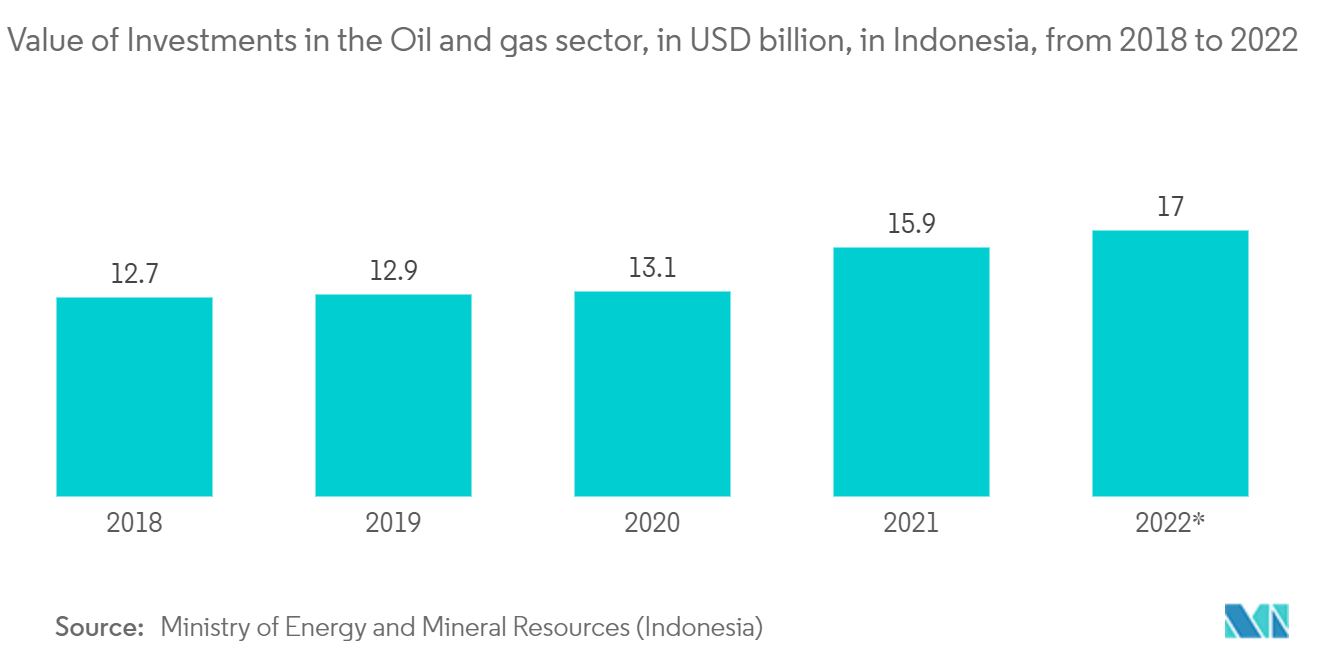
Indonesia's Automation and Control System Industry Overview
The Indonesia Automation and Control System Market is moderately competitive and consists of several major players. In terms of market share, few major players currently dominate the market. These major players with a prominent market share are focusing on expanding their customer base across numerous countries.
In April 2022, Rockwell Automation strengthened its partner network with its latest partnership with CAD-IT, a Singapore-based Industry 4.0 technologies provider. CAD-IT has a vast network in Southeast Asia, with a presence in multiple countries, including Indonesia. Through the partnership, CAD-IT will offer Rockwell Automation’s smart manufacturing and automation solutions, among other solutions.
In April 2021, Siemens added new servo motors to its Sinamics S210 single-cable servo drive system, further expanding its range of applications. Particularly for use in the pharmaceutical and food industries, the company launched the Simotics S-1FS2, a motor version with a stainless-steel housing, the highest degree of protection IP67/IP69, and high-resolution 22-bit absolute multiturn encoders.
Indonesia's Automation and Control System Market Leaders
Yokogawa Corporation
Siemens AG
Honeywell International Inc.
Rockwell Automation Inc.
Schneider Electric Co.
*Disclaimer: Major Players sorted in no particular order
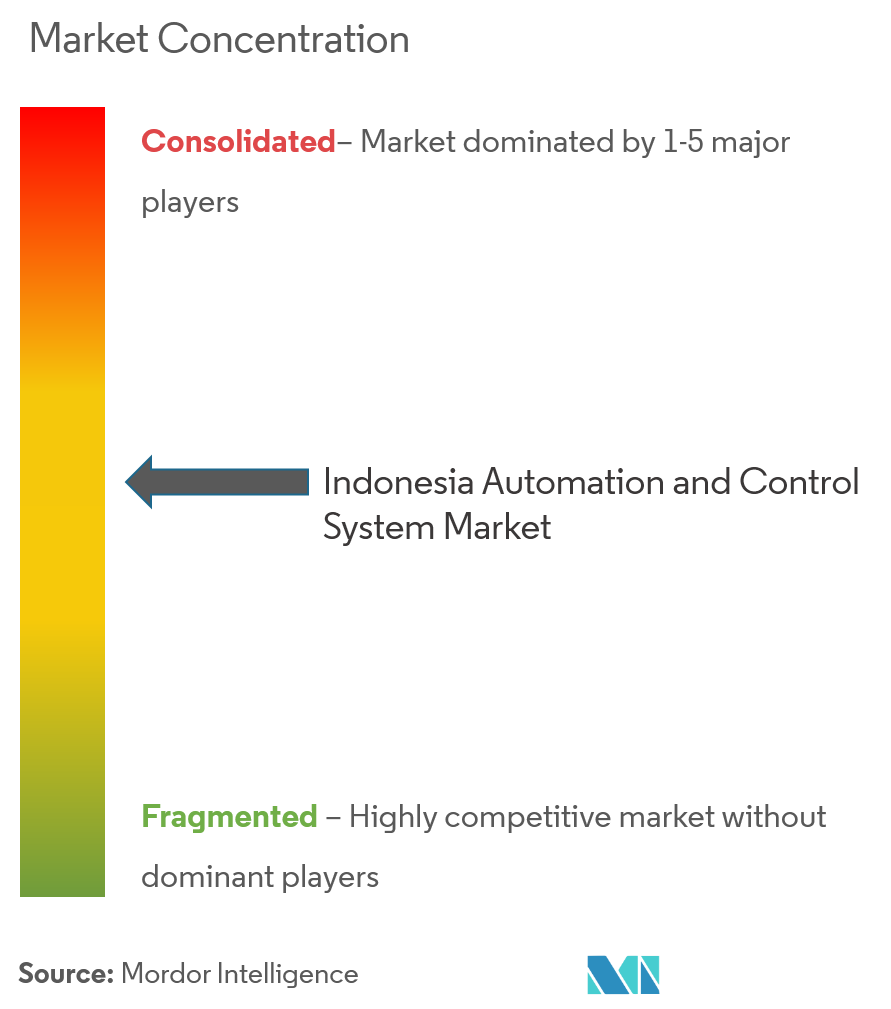
Indonesia's Automation and Control System Market News
- October 2022: Emerson announced the release of its advanced automation platform, Movicon.NExT 4.2. The software is designed to easily interface with any field device and control or enterprise system, connecting users and OEMs with the data and insights needed to achieve operational excellence across a wide range of applications, including discrete and hybrid manufacturing, like food and beverage and packaged consumer goods, as well as energy, infrastructure, building automation, and machine automation.
- July 2022: Rockwell Automation announced the launch of the PowerFlex AC variable frequency drive portfolio in Asia Pacific to support a broader range of motor control applications. The new PowerFlex 755TS drive is the company's first six-pulse drive to incorporate TotalFORCE technology.
Indonesia's Automation and Control System Market Report - Table of Contents
1. INTRODUCTION
1.1 Study Assumptions and Market Definition
1.2 Scope of the Study
2. RESEARCH METHODOLOGY
3. EXECUTIVE SUMMARY
4. MARKET DYNAMICS
4.1 Market Overview
4.2 Market Drivers
4.2.1 Flourishing Power Sector and Increased Power Generation Capacities in Indonesia
4.2.2 Evolution and Development of Wireless Protocols and Wireless Sensor Network Technology in Indonesia
4.2.3 Development of Industries and Investments to Increase Capacities
4.3 Market Restraints
4.3.1 High Capital Investments
4.3.2 Fluctuating Commodity Prices and Volatile Economic Scenario
4.4 Industry Attractiveness - Porter Five Forces
4.4.1 Threat of New Entrants
4.4.2 Bargaining Power of Buyers
4.4.3 Bargaining Power of Suppliers
4.4.4 Threat of Substitute Products
4.4.5 Intensity of Competitive Rivalry
4.5 Assessment of the impact of COVID-19 on the industry
5. MARKET SEGMENTATION
5.1 Product
5.1.1 Programmable Logic Controller
5.1.2 Supervisory Control and Data Acquisition
5.1.3 Distributed Control System
5.1.4 Human Machine Interface
5.1.5 Safety Systems
5.1.6 Industrial Robotics
5.1.7 Electric Motors (includes AC, DC, EC, Servo and Stepper Motors)
5.1.8 Drives (includes AC,DC and Servo)
5.2 End User Industry
5.2.1 Oil & Gas
5.2.2 Power
5.2.3 Chemical & Petrochemical
5.2.4 Food & Beverage
5.2.5 Metals & Mining
5.2.6 Water and Wastewater
5.2.7 Other End User Industries
6. COMPETITIVE LANDSCAPE
6.1 Company Profiles
6.1.1 Yokogawa Corporation
6.1.2 Siemens AG
6.1.3 Honeywell International Inc.
6.1.4 Rockwell Automation Inc.
6.1.5 Schneider Electric Co.
6.1.6 ABB Ltd.
6.1.7 Emerson Electric Co.
6.1.8 PT FANUC Indonesia
- *List Not Exhaustive
7. IMPORT ANALYSIS OF ELECTRIC MOTORS AND INDUSTRIAL ROBOTS
8. INVESTMENT ANALYSIS
9. FUTURE OF THE MARKET
Indonesia's Automation and Control System Industry Segmentation
Industrial automation is applying different and combined control systems to manage and operate machines and equipment in production facilities and factories. In addition to reducing costs, automation is being demanded to help increase productivity, aesthetics, efficiency, and delivery systems in the production of automotive assemblies, aircraft, steering and ship stabilization, heat-treating boilers and ovens, and other machinery.
Indonesia's Automation and Control System Market is segmented by Product (Programmable Logic Controller, Supervisory Control and Data Acquisition, Distributed Control System, Human Machine Interface, Safety Systems, Industrial Robotics, Electric Motors, Drives) and End User Industry (Oil & Gas, Power, Chemical & Petrochemical, Food & Beverage, Metals & Mining, Water and Wastewater). The market sizes and forecasts are provided in terms of value (USD million) for all the above segments.
| Product | |
| Programmable Logic Controller | |
| Supervisory Control and Data Acquisition | |
| Distributed Control System | |
| Human Machine Interface | |
| Safety Systems | |
| Industrial Robotics | |
| Electric Motors (includes AC, DC, EC, Servo and Stepper Motors) | |
| Drives (includes AC,DC and Servo) |
| End User Industry | |
| Oil & Gas | |
| Power | |
| Chemical & Petrochemical | |
| Food & Beverage | |
| Metals & Mining | |
| Water and Wastewater | |
| Other End User Industries |
Indonesia's Automation and Control System Market Research FAQs
What is the current Indonesia Automation and Control System Market size?
The Indonesia Automation and Control System Market is projected to register a CAGR of 8.5% during the forecast period (2023-2027).
Who are the key players in Indonesia Automation and Control System Market?
Yokogawa Corporation, Siemens AG, Honeywell International Inc., Rockwell Automation Inc. and Schneider Electric Co. are the major companies operating in the Indonesia Automation and Control System Market.
Indonesia's Automation and Control System Industry Report
Statistics for the 2023 Indonesia's Automation and Control System market share, size and revenue growth rate, created by Mordor Intelligence™ Industry Reports. Indonesia's Automation and Control System analysis includes a market forecast outlook to 2028 and historical overview. Get a sample of this industry analysis as a free report PDF download.
